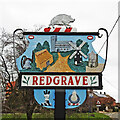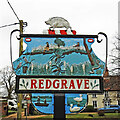1
Churchway, Redgrave
Near Redgrave Cricket Ground
Image: © Geographer
Taken: 3 Mar 2015
0.02 miles
2
Churchway, Redgrave
At the junction with Churchway
Image: © Geographer
Taken: 3 Mar 2015
0.03 miles
3
Churchway, Redgrave
Near Redgrave Cricket Ground
Image: © Geographer
Taken: 3 Mar 2015
0.03 miles
4
Houses in Churchway, Redgrave, Suffolk
From the B1113 these houses which are in Churchway, can be seen from across the meadow.
Image: © Adrian S Pye
Taken: 31 Aug 2010
0.03 miles
5
Churchway, Redgrave
At the junction with Churchway
Image: © Geographer
Taken: 3 Mar 2015
0.04 miles
6
The Knoll & Village Sign, Redgrave
The boar surmounting the sign is the crest of Sir Nicholas Bacon, Lord Keeper to Elizabeth I. He built the old Redgrave Hall. The wooden structure is a bus shelter. http://redgrave.onesuffolk.net/
Image: © Charles Greenhough
Taken: 8 Dec 2010
0.06 miles
7
Churchway, Redgrave
Image: © Geographer
Taken: 3 Mar 2015
0.06 miles
8
Redgrave village sign (east face)
If you wonder why the sign is surmounted by a boar, it refers to the Bacon family. The first Sir Nicholas Bacon bought the Manor of Redgrave after the reformation and started to build Redgrave Hall in 1545. He was Queen Elizabeth’s Lord Keeper and was knighted by her. He died in 1579 and was buried in the old St Pauls, and was succeeded by his son, another Nicholas. The second Sir Nicholas Bacon, was the first man to be created a baronet in 1611. He would serve on many commissions in his lifetime, and so began a dynasty. He and his wife, Anne are buried in Redgrave church which is depicted immediately below. The sign is double sided. The windmill which stood northwest of the village centre, no longer exists, it was destroyed by fire in 1924. A building with a barn door was a thatched barn in the middle of The Street, which has been converted into three houses. The single church bell is a homage to bell founder John Goldsmith who lived in the village. The organ, being played on the right, recalls Redgrave’s organ builder, Joseph Hart, who had a workshop in his garden. On the spandrels are heraldic crests of the Holt and Wilson families.
https://www.geograph.org.uk/photo/6774553
Image: © Adrian S Pye
Taken: 5 Mar 2021
0.06 miles
9
Redgrave village sign (west face)
On the “Fen” side a man is seen digging peat, which was used for fuel, and created the open water, while a second man is cutting reed for thatching. Two raft spiders, for which Redgrave Fen is famous are shown in the centre. Other wildlife depicted, include the willow warbler and reed bunting, stinkhorn fungi and grass snakes. Illustrated on the spandrels are two men in a boat, one wildfowling with a gun and the other fishing with rod in hand. The white ducks are probably a reference to Button’s duck factory which is now Gressingham Foods. https://www.geograph.org.uk/photo/6774549
Image: © Adrian S Pye
Taken: 5 Mar 2021
0.06 miles
10
Redgrave village sign
If you wonder why the sign is surmounted by a boar, it refers to the Bacon family. The first Sir Nicholas Bacon bought the Manor of Redgrave after the reformation and started to build Redgrave Hall in 1545. He was Queen Elizabeth’s Lord Keeper and was knighted by her. He died in 1579 and was buried in the old St Pauls, and was succeeded by his son, another Nicholas. The second Sir Nicholas Bacon, was the first man to be created a baronet in 1611. He would serve on many commissions in his lifetime, and so began a dynasty. He and his wife, Anne are buried in Redgrave church which is depicted immediately below. The sign is double sided. The windmill which stood northwest of the village centre, no longer exists, it was destroyed by fire in 1924. A building with a barn door was a thatched barn in the middle of The Street, which has been converted into three houses. The single church bell is a homage to bell founder John Goldsmith who lived in the village. The organ, being played on the right, recalls Redgrave’s organ builder, Joseph Hart, who had a workshop in his garden. On the spandrels are heraldic crests of the Holt and Wilson families.
On the other side, a man is seen digging peat in Redgrave Fen, which was used for fuel, and created the open water, while a second man is cutting reed for thatching. Two raft spiders, for which Redgrave Fen is famous are shown in the centre. Other wildlife depicted, include the willow warbler and reed bunting, stinkhorn fungi and grass snakes. Illustrated on the spandrels are two men in a boat, one wildfowling with a gun and the other fishing with rod in hand. The white ducks are probably a reference to Button’s duck factory which is now Gressingham Foods. https://www.geograph.org.uk/photo/6774549 https://www.geograph.org.uk/photo/6774553
Image: © Adrian S Pye
Taken: 12 Mar 2007
0.06 miles











